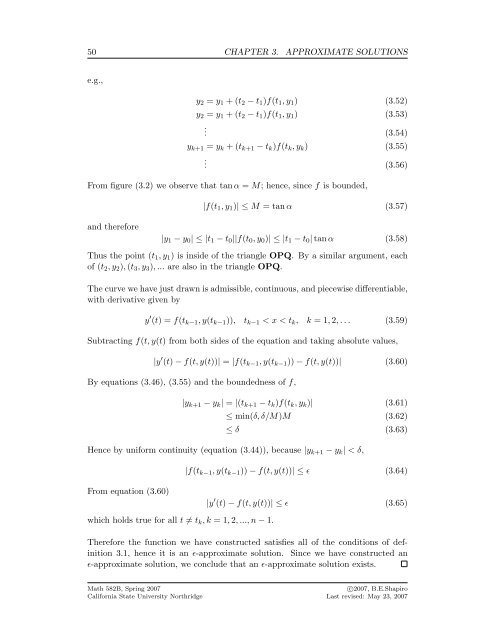The Computable Differential Equation Lecture ... - Bruce E. Shapiro
The Computable Differential Equation Lecture ... - Bruce E. Shapiro
The Computable Differential Equation Lecture ... - Bruce E. Shapiro
You also want an ePaper? Increase the reach of your titles
YUMPU automatically turns print PDFs into web optimized ePapers that Google loves.
50 CHAPTER 3. APPROXIMATE SOLUTIONS<br />
e.g.,<br />
y 2 = y 1 + (t 2 − t 1 )f(t 1 , y 1 ) (3.52)<br />
y 2 = y 1 + (t 2 − t 1 )f(t 1 , y 1 ) (3.53)<br />
. (3.54)<br />
y k+1 = y k + (t k+1 − t k )f(t k , y k ) (3.55)<br />
. (3.56)<br />
From figure (3.2) we observe that tan α = M; hence, since f is bounded,<br />
|f(t 1 , y 1 )| ≤ M = tan α (3.57)<br />
and therefore<br />
|y 1 − y 0 | ≤ |t 1 − t 0 ||f(t 0 , y 0 )| ≤ |t 1 − t 0 | tan α (3.58)<br />
Thus the point (t 1 , y 1 ) is inside of the triangle OPQ. By a similar argument, each<br />
of (t 2 , y 2 ), (t 3 , y 3 ), ... are also in the triangle OPQ.<br />
<strong>The</strong> curve we have just drawn is admissible, continuous, and piecewise differentiable,<br />
with derivative given by<br />
y ′ (t) = f(t k−1 , y(t k−1 )), t k−1 < x < t k , k = 1, 2, . . . (3.59)<br />
Subtracting f(t, y(t) from both sides of the equation and taking absolute values,<br />
|y ′ (t) − f(t, y(t))| = |f(t k−1 , y(t k−1 )) − f(t, y(t))| (3.60)<br />
By equations (3.46), (3.55) and the boundedness of f,<br />
|y k+1 − y k | = |(t k+1 − t k )f(t k , y k )| (3.61)<br />
≤ min(δ, δ/M)M (3.62)<br />
≤ δ (3.63)<br />
Hence by uniform continuity (equation (3.44)), because |y k+1 − y k | < δ,<br />
|f(t k−1 , y(t k−1 )) − f(t, y(t))| ≤ ɛ (3.64)<br />
From equation (3.60)<br />
|y ′ (t) − f(t, y(t))| ≤ ɛ (3.65)<br />
which holds true for all t ≠ t k , k = 1, 2, ..., n − 1.<br />
<strong>The</strong>refore the function we have constructed satisfies all of the conditions of definition<br />
3.1, hence it is an ɛ-approximate solution. Since we have constructed an<br />
ɛ-approximate solution, we conclude that an ɛ-approximate solution exists.<br />
Math 582B, Spring 2007<br />
California State University Northridge<br />
c○2007, B.E.<strong>Shapiro</strong><br />
Last revised: May 23, 2007
















